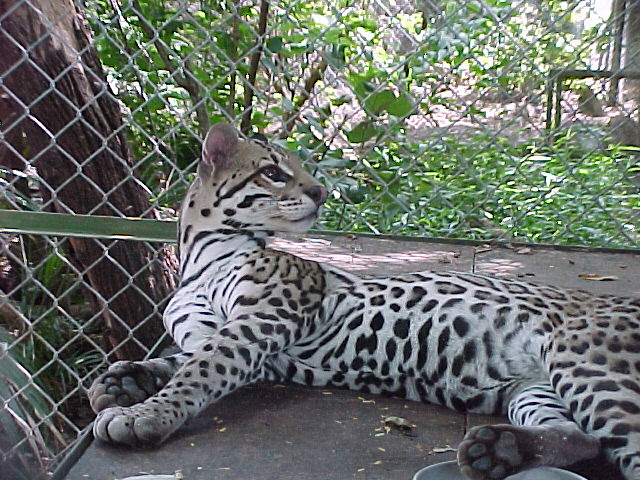
More about Ocelot
Habitat
Well adapted to dry deciduous forest, primary or secondary rainforests, and valleys.
Range
This cat has a wide range, from southern Texas to Argentina; they are usually found below elevations of 1,200 m.
Physical Description
Its massive feet grant it the Spanish name mano gordo (literally translated, "fat hand'). These feet also make this cat well adapted to tree climbing and may sleep in trees or use them to cross a stream. The base color of its coat can be grayish to cinnamon, with black spots that form streaks on the neck or elongated spots on the body. Its tail is marked with incomplete bands. Each individual has a unique coat pattern.
Biology and Natural History
This cat is very secretive, and is not usually seen; but its populations have also been devastated in the past by the fur trade. During the 1980s, 133,000 pelts were sent every year to the United States alone. Now it is illegal to import spotted furs to the US, but the ocelot is still faced with another formidable foe: extensive habitat destruction. This cat can live wherever there is sufficient vegetation cover and prey, and they are very opportunistic feeders. But without some sort of cover, they cannot hunt or live; they are rarely found far from vegetative cover.
The ocelot moves and hunts alone. The territory of an adult male may have a total area of up to 17 km2, overlapping several smaller female territories which may be approximately 15 km2. Females can have up to 4 young to a litter, but having 1 or 2 is more likely. She raises them in a secluded place. These beautiful cats are nocturnal, and sleep in trees during the day.
Diet
The ocelot hunts prey from small rodents to iguanas and peccaries.
Height/Weight
This cat has a head and body length of 0.7 to 0.9 m, and a tail of 0.28 to 0.4 m. Females are slightly smaller than males. Adults weigh about 13 kg.
Taxonomy
Order: Carnivora
Felidae: Felidae
Sources
Eisenberg, John. Mammals of the Neotropics, Vol. 1. The University of Chicago Press: Chicago, 1989.
Emmons, Louise H. Neotropical Rainforest Mammals: A Field Guide, 2nd Ed. University of Chicago Press: Chicago, 1990.
Koford, C. B. in Janzen, Daniel H. Costa Rican Natural History. Chicago: University of Chicago Press, 1983.
Wilson, D. E. in Janzen, Daniel H. Costa Rican Natural History. Chicago: University of Chicago Press, 1983.
Amy Strieter, Wildlife Writer
Ocelot Sightings
Similar Profiles
We believe travel is more than ticking destinations off a list – it’s about discovering new places deeply, feeling connected wherever you go, and knowing you have a trusted team behind you every step of the way.



